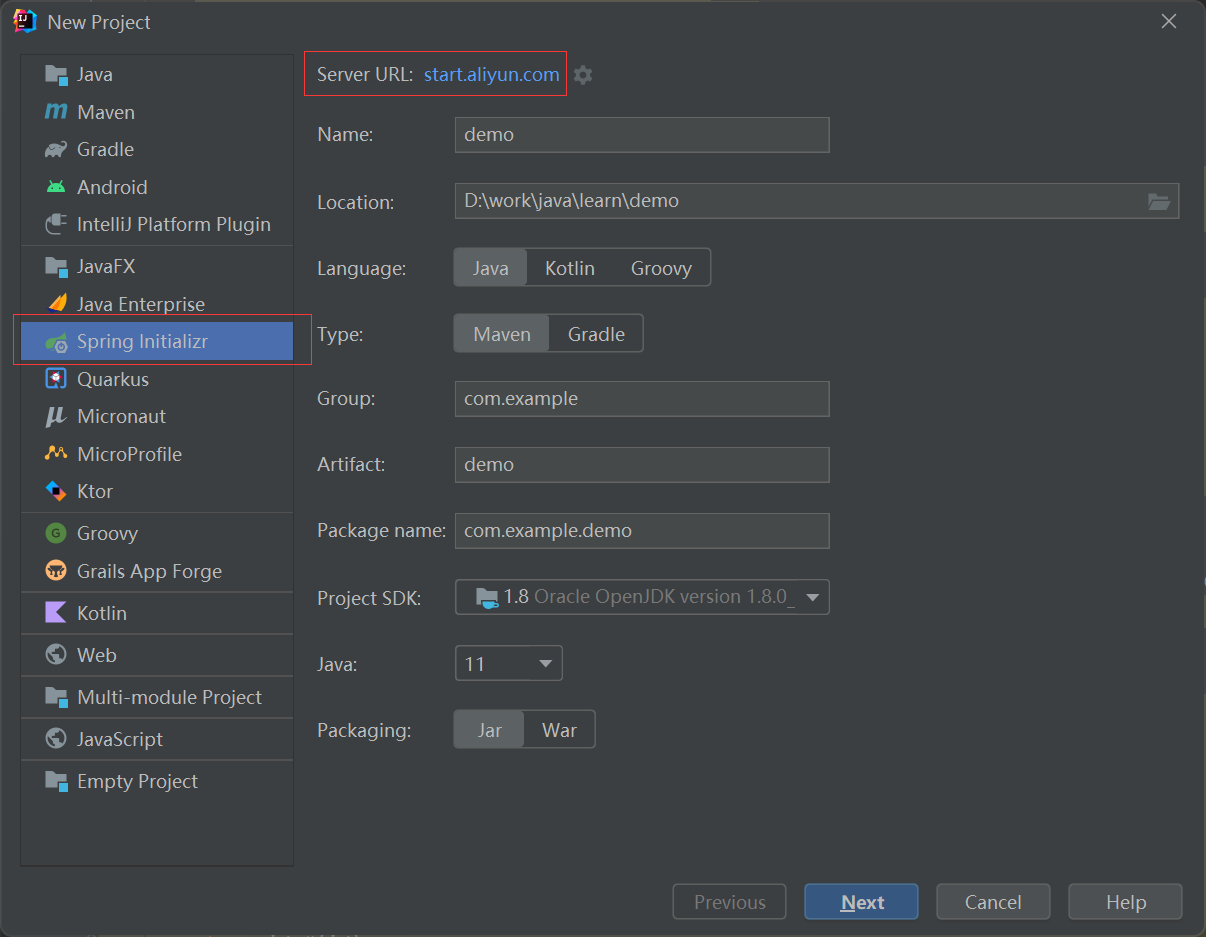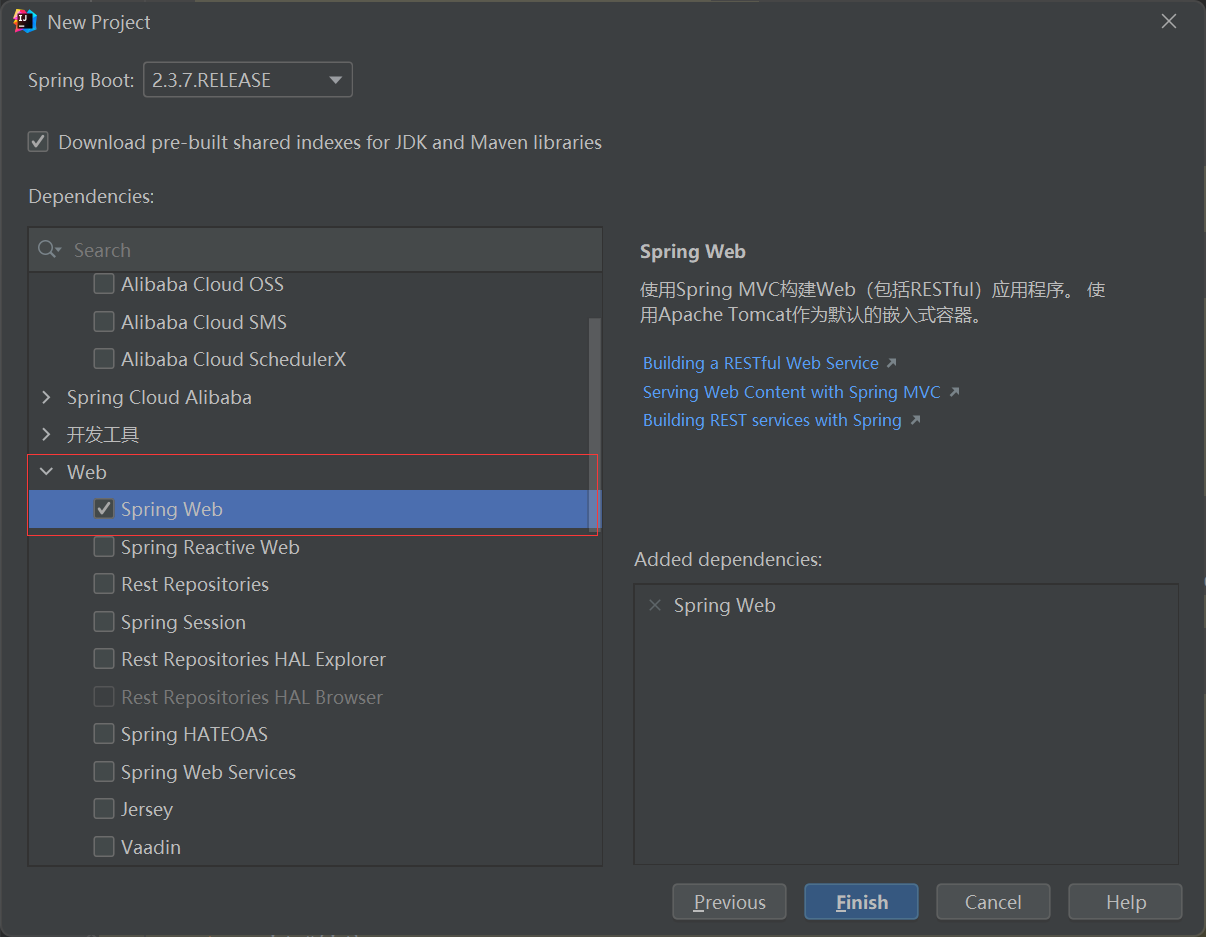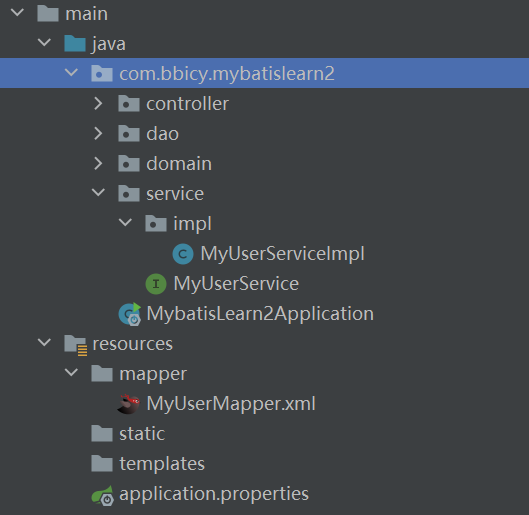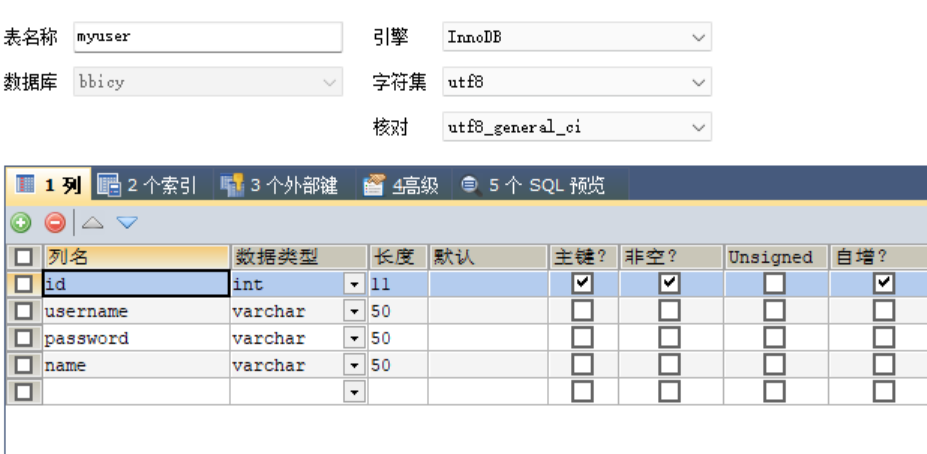SpringBoot 使用 Mybatis笔记和防坑的地方
开发工具:IntelliJ IDEA
数据库:MySQL
新建Project,选中Spring Initializr,Server URL 使用阿里云的,填入 start.aliyun.com

下一步,勾选Web->Spring Web,点Finish完成工程创建。

在pom.xml 中,加入mysql和mybatis 依赖。
1 2 3 4 5 6 7 8 9 | <dependency> <groupId>org.mybatis.spring.boot</groupId> <artifactId>mybatis-spring-boot-starter</artifactId> <version>2.0.0</version></dependency><dependency> <groupId>mysql</groupId> <artifactId>mysql-connector-java</artifactId></dependency> |
在application.properties中,指定内置服务端口号,默认是8080,加入数据库的连接信息。
1 2 3 4 | spring.datasource.url=jdbc:mysql://localhost:3306/bbicy?serverTimezone=UTC&useUnicode=true&characterEncoding=utf-8&useSSL=falsespring.datasource.username=bbicyspring.datasource.password=bbicyspring.datasource.driver-class-name=com.mysql.cj.jdbc.Driver |
在 resources目录下新建mapper目录,此目录下存放mybatis的mapper对应的xml文件。
为了能让springboot扫描到,在application.properties中设置。
1 | mybatis.mapperLocations=classpath:mapper/*.xml |
在src/main/java/默认包名目录下,依次建立以下包名
dao:存放数据访问接口
domain:存放实体对象
service:业务逻辑接口
service->Impl
service下建立Impl包名,存放service接口的实现类。
controller:http请求接口
完整的目录结构如下:

在domain中新建实体类,对应数据库的表结构。

对应的SQL语句:
1 2 3 4 5 6 7 | CREATE TABLE `myuser` ( `id` int(11) NOT NULL AUTO_INCREMENT, `username` varchar(50) DEFAULT NULL, `password` varchar(50) DEFAULT NULL, `name` varchar(50) DEFAULT NULL, PRIMARY KEY (`id`)) ENGINE=InnoDB AUTO_INCREMENT=1 DEFAULT CHARSET=utf8; |
实体类完整代码:
1 2 3 4 5 6 7 8 9 10 11 12 13 14 15 16 17 18 19 20 21 22 23 24 25 26 27 28 29 30 31 32 33 34 35 36 37 38 39 40 | package com.bbicy.mybatislearn2.domain;public class MyUser { private int id; private String username; private String password; private String name; public int getId() { return id; } public void setId(int id) { this.id = id; } public String getUsername() { return username; } public void setUsername(String username) { this.username = username; } public String getPassword() { return password; } public void setPassword(String password) { this.password = password; } public String getName() { return name; } public void setName(String name) { this.name = name; }} |
dao下新建MyUserDao,里面3个方法。
1 2 3 4 5 6 7 8 9 10 11 | package com.bbicy.mybatislearn2.dao;import com.bbicy.mybatislearn2.domain.MyUser;public interface MyUserDao { MyUser findById(int id); int insertUser(MyUser user); int updateUser(MyUser user);} |
为了能让SpringBoot容器能扫描到,在Application所在的类加入MapperScan注解。
1 | @MapperScan("com.bbicy.mybatislearn2.dao") |
在mapper目录新建MyUserMapper.xml
写3个方法对应的SQL代码
1 2 3 4 5 6 7 8 9 10 11 12 13 14 15 16 17 18 19 20 21 22 23 24 25 26 27 28 29 30 31 32 33 34 35 36 | <?xml version="1.0" encoding="UTF-8" ?><!DOCTYPE mapper PUBLIC "-//mybatis.org//DTD Mapper 3.0//EN" "http://mybatis.org/dtd/mybatis-3-mapper.dtd" ><mapper namespace="com.bbicy.mybatislearn2.dao.MyUserDao"> <resultMap id="BaseResultMap" type="com.bbicy.mybatislearn2.domain.MyUser"> <result column="id" property="id"></result> <result column="name" property="name"></result> <result column="username" property="username"></result> <result column="password" property="password"></result> </resultMap> <sql id="Base_Column_List"> id,name,username,password </sql> <select id="findById" resultMap="BaseResultMap" parameterType="int"> select <include refid="Base_Column_List"></include> from myuser where id = #{id} </select> <insert id="insertUser" parameterType="com.bbicy.mybatislearn2.domain.MyUser" useGeneratedKeys="true" keyProperty="id"> insert into myuser(username,name,password) values (#{username},#{name},#{password}) </insert> <update id="updateUser" parameterType="com.bbicy.mybatislearn2.domain.MyUser"> update myuser <trim prefix="set" suffixOverrides=","> <if test="username!=null">username=#{username},</if> <if test="name!=null">name=#{name},</if> <if test="password!=null">password=#{password},</if> </trim> where id=#{id} </update></mapper> |
在Service下新建MyUserService接口
1 2 3 4 5 6 7 8 9 | package com.bbicy.mybatislearn2.service;import com.bbicy.mybatislearn2.domain.MyUser;public interface MyUserService { MyUser findUserById(int id); int insertMyUser(MyUser user); int updateUser(MyUser user);} |
在impl新建实现类。
1 2 3 4 5 6 7 8 9 10 11 12 13 14 15 16 17 18 19 20 21 22 23 24 25 26 27 28 29 30 | package com.bbicy.mybatislearn2.service.impl;import com.bbicy.mybatislearn2.dao.MyUserDao;import com.bbicy.mybatislearn2.domain.MyUser;import com.bbicy.mybatislearn2.service.MyUserService;import org.springframework.beans.factory.annotation.Autowired;import org.springframework.stereotype.Service;@Servicepublic class MyUserServiceImpl implements MyUserService { @Autowired(required = false) private MyUserDao myUserDao; @Override public MyUser findUserById(int id) { return myUserDao.findById(id); } @Override public int insertMyUser(MyUser user) { myUserDao.insertUser(user); return user.getId(); } @Override public int updateUser(MyUser user) { return myUserDao.updateUser(user); }} |
在controller下新建MyUserController
1 2 3 4 5 6 7 8 9 10 11 12 13 14 15 16 17 18 19 20 21 22 23 24 25 26 | package com.bbicy.mybatislearn2.controller;import com.bbicy.mybatislearn2.domain.MyUser;import com.bbicy.mybatislearn2.service.MyUserService;import org.springframework.beans.factory.annotation.Autowired;import org.springframework.web.bind.annotation.RequestMapping;import org.springframework.web.bind.annotation.RestController;@RestControllerpublic class MyUserController { @Autowired private MyUserService myUserService; @RequestMapping("/api/myuser") public MyUser findMyUserById(int id){ return myUserService.findUserById(id); } @RequestMapping("/api/addmyuser") public int AddUser(MyUser user){ return myUserService.insertMyUser(user); }} |
通过http://localhost:8082/api/myuser?id=1 访问数据。
写测试代码,测试update方法。
1 2 3 4 5 6 7 8 9 10 | @Testvoid testUpdateMyUser(){ MyUser user = new MyUser(); user.setId(1); user.setUsername("user1"); //user.setName("updatedname1"); //user.setPassword("0000002"); int resultId = myUserService.updateUser(user); System.out.println("resultId:"+resultId);} |
有几个需要注意和避坑的地方:
1、application.properties设置 mybatis.mapperLocations 对应的xml路径
2、程序main方法对应的Application类,加入@MapperScan注解,设置需要扫描的dao路径
3、Service实现类,加入@Service注解,类里面的mapper变量加入@Autowired注解
4、Controller中加入@RestController、@RequestMapping注解
5、xml文件中namespace对应dao中的包名和类名
另外在SQL中注意以下几点:
insert方法默认返回影响的行数,为了得到新插入数据的主键。做如下设置
1、数据库是mysql,主键是自增
2、insert标签 useGeneratedKeys="true" keyProperty="id" ,其中keyProperty是Java对象的属性名
3、Mybatis执行完插入语句后,自动将自增长值赋值给对象的id。因此,可通过MyUser对应的getter方法获取!
1 2 3 | <insert id="insertUser" parameterType="com.bbicy.mybatislearn2.domain.MyUser" useGeneratedKeys="true" keyProperty="id"> insert into myuser(username,name,password) values (#{username},#{name},#{password}) </insert> |
1 2 | myUserDao.insertUser(user);return user.getId(); |
update方法,
1、有时候不需要更新所有的数据,可以通过if test 来判断,特别注意这里不用加#{xxx}标签。设置了对应的属性之后才更新对应的字段信息。
2、因为动态拼凑SQL语句,set 字段名1=xxx,字段名2=xxx where xxx ,这里的逗号需要动态处理,可以用trim来处理。
prefix 给sql语句拼接的前缀
suffix 给sql语句拼接的后缀
prefixOverrides 去除sql语句前面的关键字或者字符,该关键字或者字符由prefixOverrides属性指定,假设该属性指定为"AND",当sql语句的开头为"AND",trim标签将会去除该"AND"
suffixOverrides 去除sql语句后面的关键字或者字符,该关键字或者字符由suffixOverrides属性指定,比如逗号。
1 2 3 4 5 6 7 8 9 | <update id="updateUser" parameterType="com.bbicy.mybatislearn2.domain.MyUser"> update myuser <trim prefix="set" suffixOverrides=","> <if test="username!=null">username=#{username},</if> <if test="name!=null">name=#{name},</if> <if test="password!=null">password=#{password},</if> </trim> where id=#{id}</update> |
为了调试方便,可以讲SQL语句打印在控制台,在application.properties设置
1 2 | logging.level.com.bbicy.mybatislearn2.dao=debugmybatis.configuration.log-impl=org.apache.ibatis.logging.stdout.StdOutImpl |
注意:logging.level.com,后面的路径指的是mybatis对应的dao方法接口所在的包。并不是mapper.xml所在的包
在控制台输出的SQL调试信息





【推荐】国内首个AI IDE,深度理解中文开发场景,立即下载体验Trae
【推荐】编程新体验,更懂你的AI,立即体验豆包MarsCode编程助手
【推荐】抖音旗下AI助手豆包,你的智能百科全书,全免费不限次数
【推荐】轻量又高性能的 SSH 工具 IShell:AI 加持,快人一步
· winform 绘制太阳,地球,月球 运作规律
· 震惊!C++程序真的从main开始吗?99%的程序员都答错了
· AI与.NET技术实操系列(五):向量存储与相似性搜索在 .NET 中的实现
· 超详细:普通电脑也行Windows部署deepseek R1训练数据并当服务器共享给他人
· 【硬核科普】Trae如何「偷看」你的代码?零基础破解AI编程运行原理